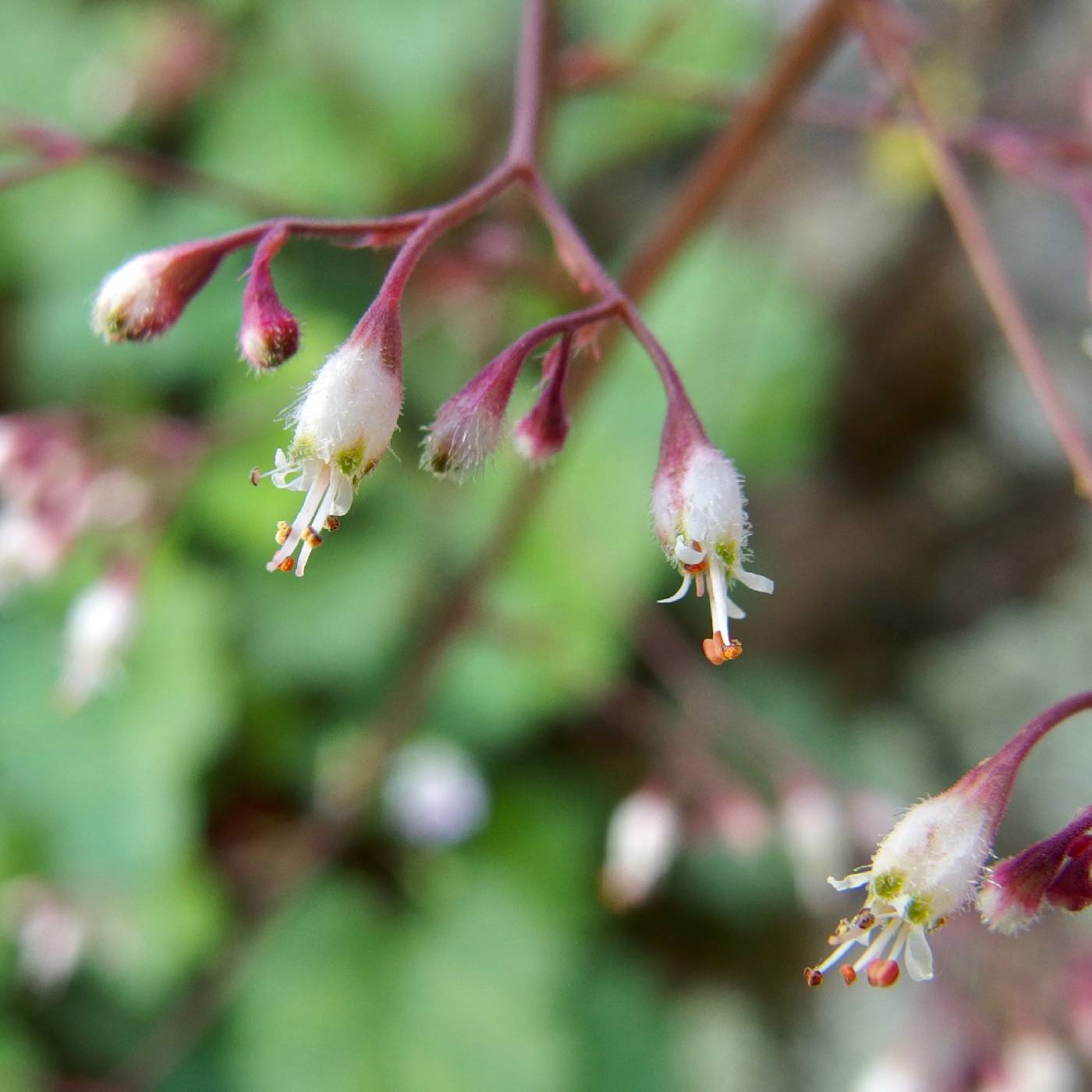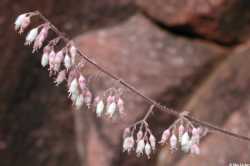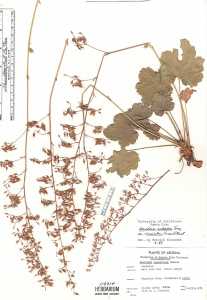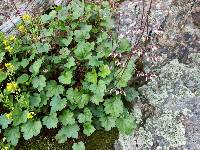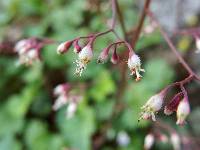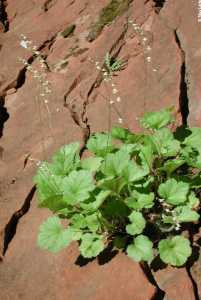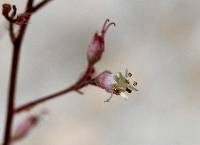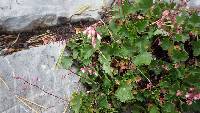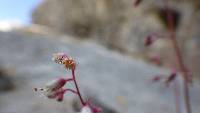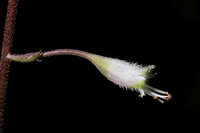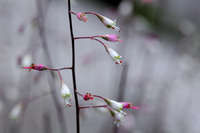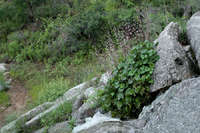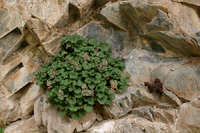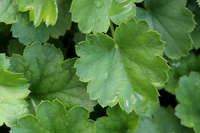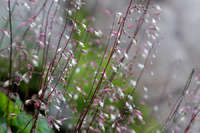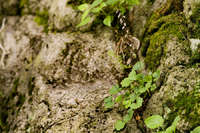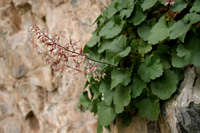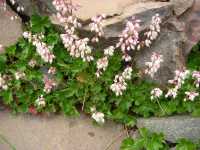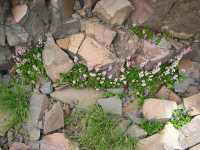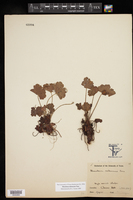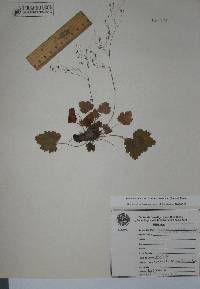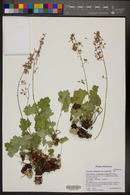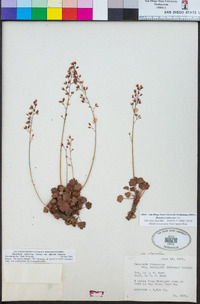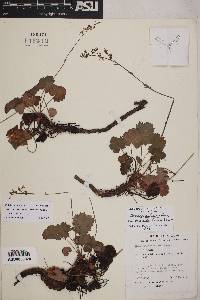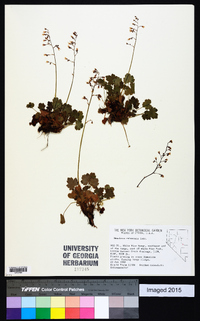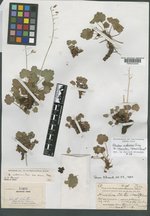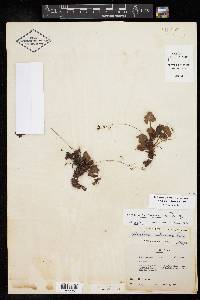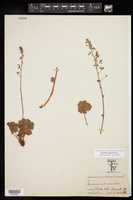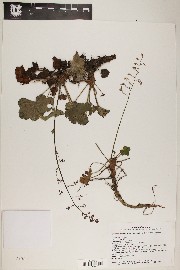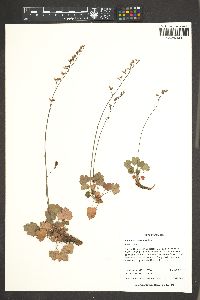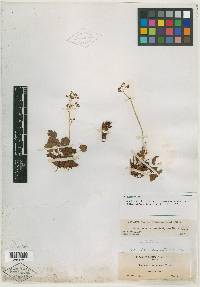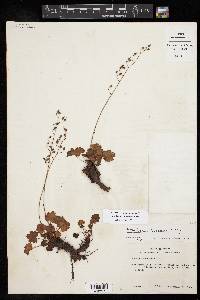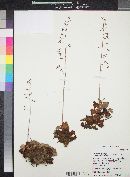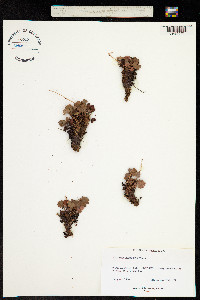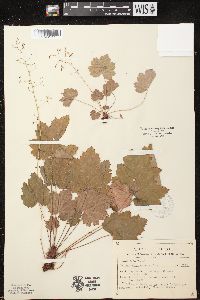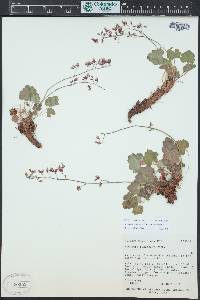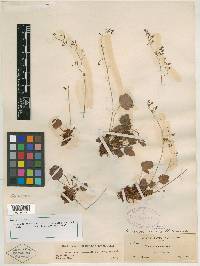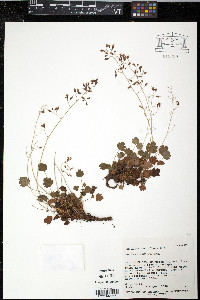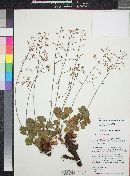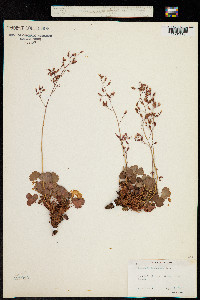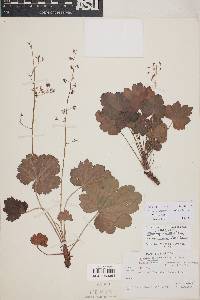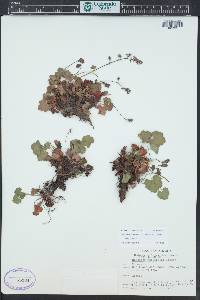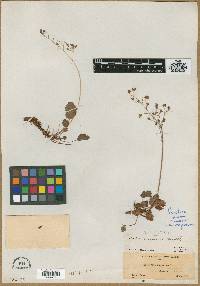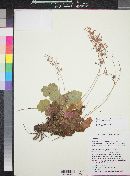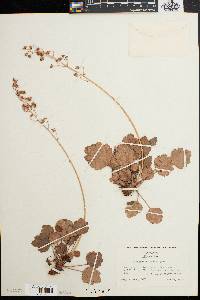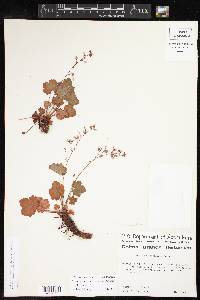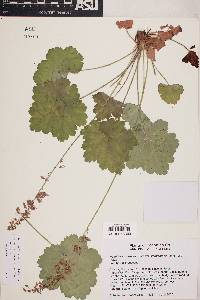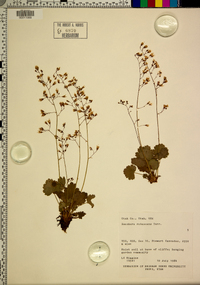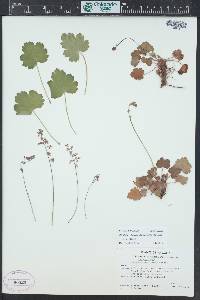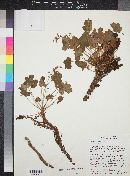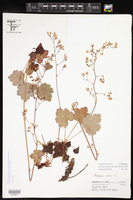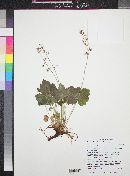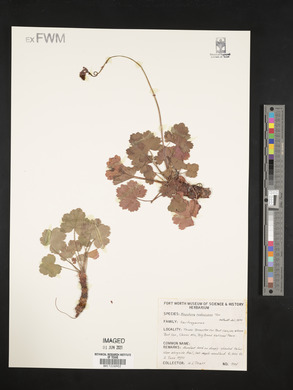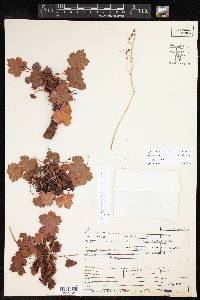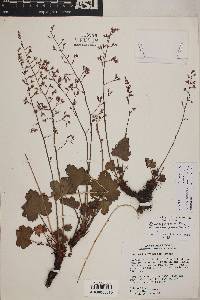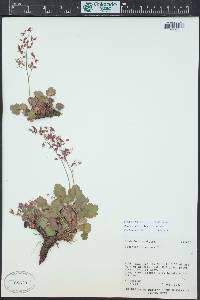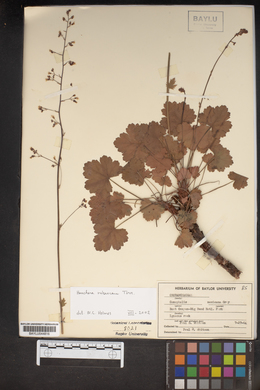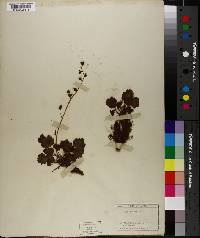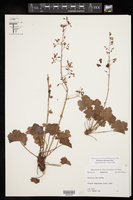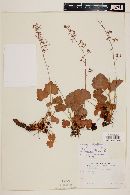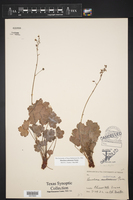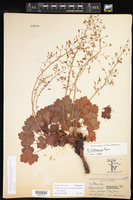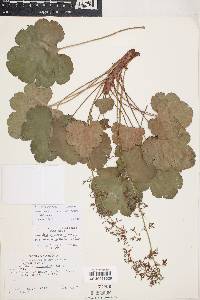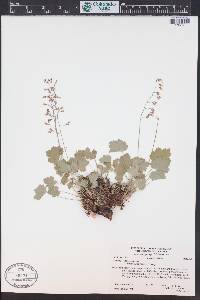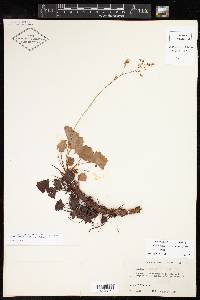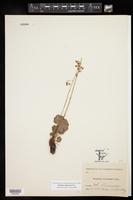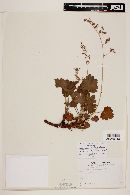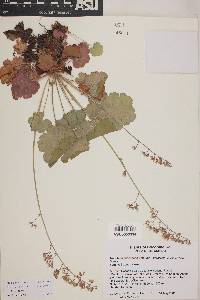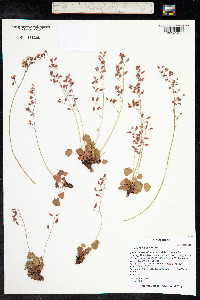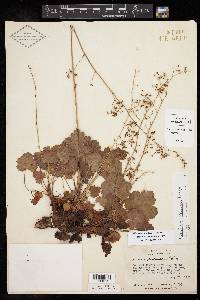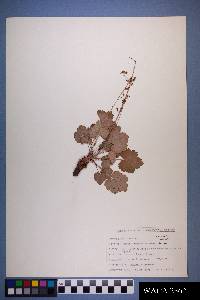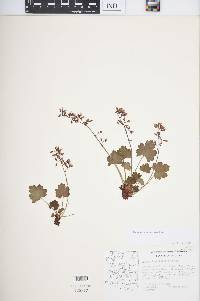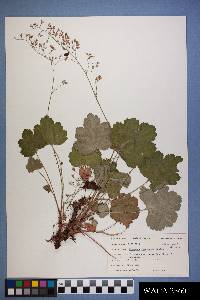Heuchera rubescens
|
|
|
|
Family: Saxifragaceae
Pink Alumroot
[Heuchera clutei, moreHeuchera rubescens var. oregonensis] |
Herbs acaulescent or subcaulescent; caudex branched. Flowering stems (6-)10-32(-50) cm, short stipitate-glandular. Leaves: petiole glabrous or short to long stipitate-glandular; blade suborbiculate or broadly ovate, shallowly 3-7-lobed, 0.6-4.5 cm, base cordate or truncate, lobes rounded, margins dentate, apex acute or acuminate, surfaces glabrous or long stipitate-glandular on veins abaxially, glabrous or short stipitate-glandular adaxially. Inflorescences dense, diffuse in fruit, (often secund). Flowers: hypanthium slightly bilaterally symmetric, free 0.5-2 mm, longer on adaxial side, pink to rose, narrowly campanulate with obconic base, becoming urceolate, 3-6.5 mm, short stipitate-glandular proximally, long stipitate-glandular distally; sepals erect, often green- or red-tipped, equal or unequal (longer on abaxial side of hypanthium), 1-3.3 mm, apex obtuse or rounded; petals spreading, pink, linear or narrowly oblanceolate, (clawed, ± equal), unlobed, 2-3(-6) mm (equaling or longer than sepals, rarely shorter), margins entire; stamens exserted 0.8-3 mm; styles exserted 0.5-2 mm, 1.5-2.5 mm, to 0.1 mm diam. Capsules urceolate, 3-6 mm; beaks divergent, papillose or not. Seeds dark brown, fusiform, 0.5-0.9 mm. 2n = 14, 28. Flowering Apr-Sep. Cracks and ledges in shaded rocky cliffs and outcrops; 900-3700 m; Ariz., Calif., Colo., Idaho, Nev., N.Mex., Oreg., Texas, Utah; Mexico (Baja California). Heuchera rubescens occurs throughout most of the Intermountain Region except the Uinta Mountains and basin in Utah. This complex has always been extremely difficult taxonomically. Almost every minor variant in such characters as the level of insertion of stamens in relation to petals, the shape and length of hypanthium and petals, the size, hairiness, and shape of leaf blades, and the length of petioles has been given a name and recognized at various taxonomic ranks, often without correlation to any pattern of geographical distribution. We agree with P. K. Holmgren and N. H. Holmgren (1997) that, pending a thorough phylogenetic study, it seems best to recognize a single polymorphic species without infraspecific taxa.
Plant: Perennial herb Leaves: blades 0.8-6 cm long, circular to broadly ovate, more or less deeply 5-9 lobed, the lobes crenate to dentate and apiculate to aristate; petioles glandular pubescent to densely hirsute, 1-11 cm long INFLORESCENCE: narrow, cylindrical to conical, often more or less secund, 7-53 cm tall Flowers: narrow, cylindrical to conical, often more or less secund, 7-53 cm tall Fruit: FRUITS 2-valved; SEEDS smooth to ridged Misc: Dry, rocky areas. --6 intergrading vars.; AZ, CA, CO, ID, NM, NV, OR, TX. UT, and n Mex. Apparently closely related to H. parishii Rydberg of CA and H. mexicana Rydberg of Mex. Appears to hybridize with other spp. and needs monographic study. REFERENCES: Elvander, Patrick. 1992. Saxifragaceae. Ariz.-Nev. Acad. Sci. 26(1)2. FNA 2009, VPAP (Elvander 1992), Allred and Ivey 2012 Duration: Perennial Nativity: Native Lifeform: Forb/Herb General: Perennial herb, 10-30 cm tall (occasionally up to 50 cm), from a stout, branched caudex and woody, scale-covered rhizomes; stems leafless, erect, slender, terminating in an inflorescence. Leaves: Clustered in a basal tuft, on glandular or hairy petioles 1-11 cm long; blades 1-6 cm long, round (orbicular) and shallowly 3-9 lobed, the margins of the lobes crenate to dentate; the surfaces glabrous or stipitate-glandular, sometimes with glands on the veins only. Flowers: Small and pinkish, in narrow panicles that terminate the leafless stems; flowers slightly asymmetrical; sepals 5 per flower, oblong-ovate, unequal in size, 1-3 mm long, white to pink with green tips, turning deep red with age; petals 5 per flower, 4-6 mm long, narrowly oblanceolate or thread-like, pink. Fruits: Capsules urn-shaped, 3-6 mm long, topped with 2 divergent beaks; capsules split open between the beaks to release dark brown, spindle-shaped seeds, less than 1 mm long. Ecology: Found in crevices of rocky cliffs and outcrops in the mountains, from 4,000-12,000 ft (1219-3658 m); flowers May-September. Distribution: OR, ID, UT, and CO; south to TX, NM, AZ and CA Notes: Look for basal clusters of round, palmately lobed leaves on long petioles; slender leafless flowering stalks emerge from among the leaf clusters and are topped by narrow but open panicles of pinkish flowers. Distinguished from other Heuchera spp. by its flowers, which have white to pink sepals with green tips; the stamen and styles stick out of the flower (are strongly exserted), being obviously longer than the sepals and petals; and the flowers are slighly asymmetrical, with a slightly lopsided hypanthium and sepals not all the same size. This species is quite variable and over the years has been divided up into many varieties. Flora of North America (2009) opts out of recognizing any varieties until extensive molecular work is done on the species. Allred and Ivey (2012) also chose not to recognize infraspecific taxa. Ethnobotany: A decoction of roots was used to treat venereal disease, high fever, heart trouble, colic in babies, and general debility. An infusion of roots used as an eyewash and to treat diarrhea and liver trouble. Mashed, boiled leaves were used as a wash for horses’ saddle sores, and soaked roots were given to horses and cows for cramps. Etymology: Heuchera honors Johann Heinrich Heucher (1677-1747), German professor of medicine and botany at Wittenberg, who specialized in medicinal plants; rubescens means reddish. Synonyms: Heuchera leptomeria, H. pringlei, H. versicolor Editor: AHazelton 2017 |
|
|
|

